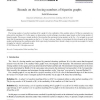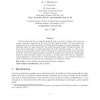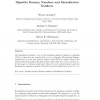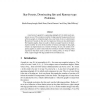53 search results - page 1 / 11 » Bounds on the forcing numbers of bipartite graphs |
DM
2006
13 years 4 months ago
2006
The forcing number of a perfect matching M of a graph G is the cardinality of the smallest subset of M that is contained in no other perfect matching of G. In this paper, we demon...
SIAMDM
2008
13 years 4 months ago
2008
We first show that for any bipartite graph H with at most five vertices, there exists an on-line competitive algorithm for the class of H-free bipartite graphs. We then analyze th...
ALGORITHMICA
2004
13 years 4 months ago
2004
We consider the Chromatic Sum Problem on bipartite graphs which appears to be much harder than the classical Chromatic Number Problem. We prove that the Chromatic Sum Problem is NP...
DM
2000
13 years 4 months ago
2000
The Zarankiewicz number z(s, m) is the maximum number of edges in a subgraph of K(s, s) that does not contain K(m, m) as a subgraph. The bipartite Ramsey number b(m, n) is the lea...
DM
2002
13 years 4 months ago
2002
A star forest of a graph G is a spanning subgraph of G in which each component is a star. The minimum number of edges required to guarantee that an arbitrary graph, or a bipartite...




